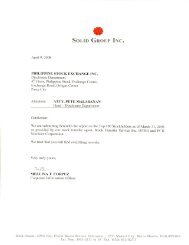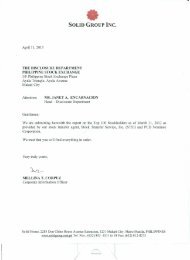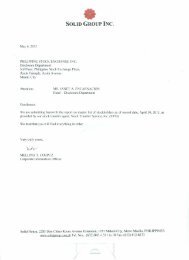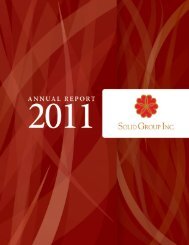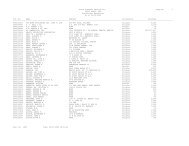SEC Form 17-A: Annual Report - the solid group inc website
SEC Form 17-A: Annual Report - the solid group inc website
SEC Form 17-A: Annual Report - the solid group inc website
You also want an ePaper? Increase the reach of your titles
YUMPU automatically turns print PDFs into web optimized ePapers that Google loves.
- 12 -<br />
Goodwill (positive) represents <strong>the</strong> excess of acquisition cost over <strong>the</strong> Parent’s<br />
share in <strong>the</strong> fair value of <strong>the</strong> identifiable net assets of <strong>the</strong> acquired subsidiary at <strong>the</strong><br />
date of acquisition. Negative goodwill represents <strong>the</strong> excess of Parent Company’s<br />
share in <strong>the</strong> fair value of identifiable net assets of <strong>the</strong> subsidiary at date of<br />
acquisition over acquisition cost.<br />
On initial recognition, <strong>the</strong> assets and liabilities of <strong>the</strong> subsidiary are <strong>inc</strong>luded in <strong>the</strong><br />
con<strong>solid</strong>ated statement of financial statement at <strong>the</strong>ir fair values, which are also<br />
used as <strong>the</strong> bases for subsequent measurement in accordance with <strong>the</strong> Group’s<br />
accounting policies.<br />
(b)<br />
Transactions with NCI<br />
The Group’s transactions with NCI that do not result in loss of control are<br />
accounted for as equity transactions – that is, as transaction with <strong>the</strong> owners of<br />
<strong>the</strong> Group in <strong>the</strong>ir capacity as owners. The difference between <strong>the</strong> fair value of<br />
any consideration paid and <strong>the</strong> relevant share acquired of <strong>the</strong> carrying value of <strong>the</strong><br />
net assets of <strong>the</strong> subsidiary is recognized in equity. Disposals of equity<br />
investments to NCI interests result in gains and losses for <strong>the</strong> Group that are also<br />
recognized in equity.<br />
When <strong>the</strong> Group ceases to have control over a subsidiary, any retained interest in<br />
<strong>the</strong> entity is remeasured to its fair value at <strong>the</strong> date when control is lost, with <strong>the</strong><br />
change in carrying amount recognized in profit or loss. The fair value is <strong>the</strong> initial<br />
carrying amount for <strong>the</strong> purposes of subsequently accounting for <strong>the</strong> retained<br />
interest as an associate, joint venture or financial asset. In addition, any amounts<br />
previously recognized in o<strong>the</strong>r comprehensive <strong>inc</strong>ome in respect of that entity are<br />
accounted for as if <strong>the</strong> Group had directly disposed of <strong>the</strong> related assets or<br />
liabilities. This may mean that amounts previously recognized in o<strong>the</strong>r<br />
comprehensive <strong>inc</strong>ome are reclassified to profit or loss.<br />
2.4 Segment <strong>Report</strong>ing<br />
Operating segments are reported in a manner consistent with <strong>the</strong> internal reporting<br />
provided to <strong>the</strong> Group’s strategic steering committee; its chief operating<br />
decision-maker. The strategic steering committee is responsible for allocating resources<br />
and assessing performance of <strong>the</strong> operating segments.<br />
In identifying its operating segments, management generally follows <strong>the</strong> Group’s<br />
products and service lines as disclosed in Note 4, which represent <strong>the</strong> main products<br />
and services provided by <strong>the</strong> Group.<br />
Each of <strong>the</strong>se operating segments is managed separately as each of <strong>the</strong>se service lines<br />
requires different technologies and o<strong>the</strong>r resources as well as marketing approaches.<br />
All inter-segment transfers are carried out at arm’s length prices.<br />
The measurement policies <strong>the</strong> Group uses for segment reporting under PFRS 8,<br />
Operating Segments, are <strong>the</strong> same as those used in its financial statements. However,<br />
corporate assets which are not directly attributable to <strong>the</strong> business activities of any<br />
operating segment are not allocated to any segment.<br />
There have been no changes from prior periods in <strong>the</strong> measurement methods used to<br />
determine reported segment profit or loss.



